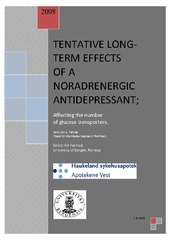Tentative longterm effects of a noradrenergic antidepressant; affecting the number of glucose transporters
Abstract
Major depressive disorder is an affective disorder affecting millions of people worldwide. Only in Europe at least 21 million are thought to be affected. Several theories have been developed during the years trying to explain the cause of depression. This study is based on the theory where major depressive disorder is believed to be caused by impaired cerebral glucose metabolism, proposed by Hundal in 2006.The astroglia are thought to be the primary affected cells. The glucose transporters GLUT1 and GLUT3 are found to function in cerebral glucose metabolism. Noradrenergic influence is found to stimulate and increase the amount of several glucose transporters on the surface of different cell types. In this study rats are given the antidepressives fluoxetine, which selectively inhibits serotonin reuptake, reboxetine, which selectively inhibits reuptake of noradrenaline and sibutramine, an anti-obesity drug, which inhibits both serotonin and noradrenaline reuptake. The aim of the study is to compare the different drugs to investigate if continuous noradrenergic stimulation is able to upregulate the amounts of GLUT1 and GLUT3 in rat brain. The animals got the drugs dissolved in their drinking water for 18 weeks and their brain was analyzed for further investigation. Parts of the brain were cut into sections followed by immunohistochemical antibody staining. However, blood samples revealed great variations in concentration of drugs within the groups of rats receiving the same drug and it is unsure if the blood sampling procedure was performed satisfyingly. The staining results also turned out quite variable and it was difficult to make any conclusions regarding the possible long-term effects of any of the drugs.
Publisher
The University of BergenCopyright
Copyright the author. All rights reservedThe author
